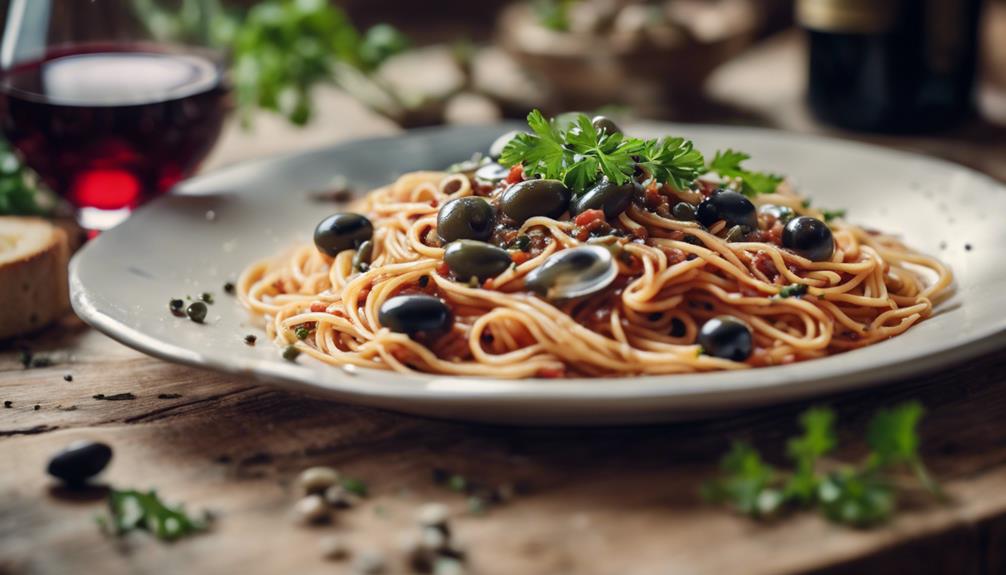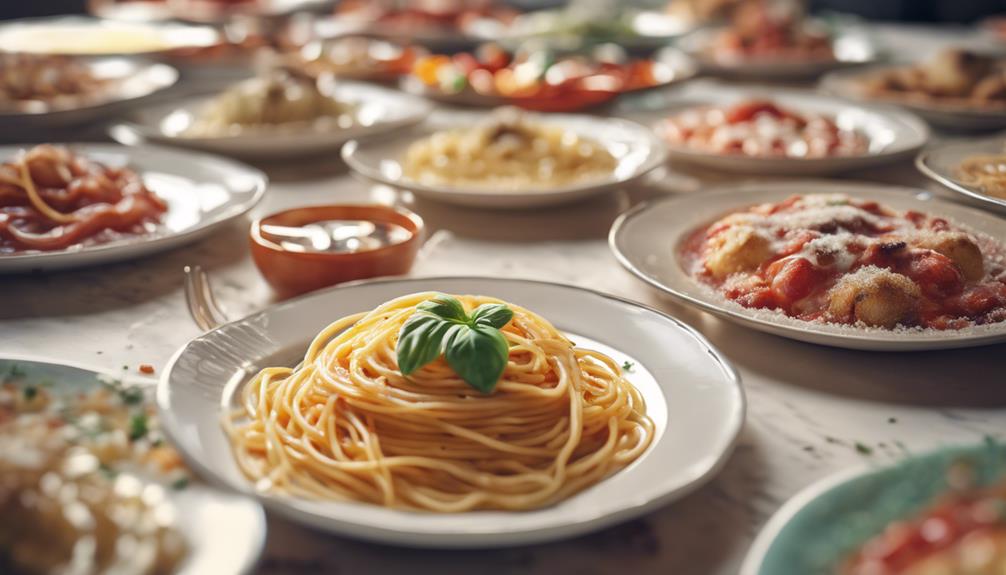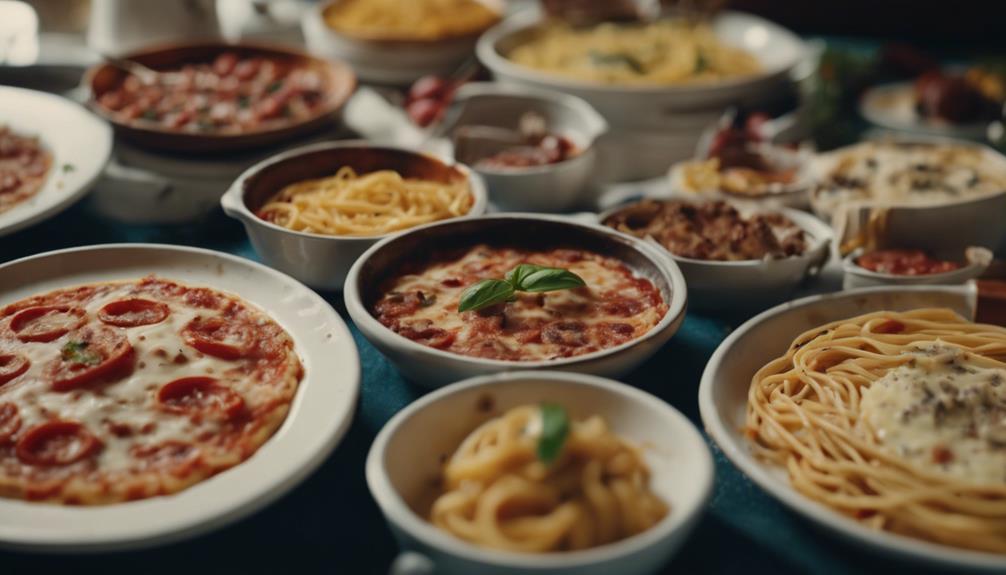Spaghetti Puttanesca is a famous Italian pasta dish full of bold and savory flavors, featuring capers, olives, and anchovies. Originally from Naples in the mid-20th century, this dish showcases a strong Mediterranean influence, evident in its robust taste. Highlighting umami-packed anchovies, briny olives, and zesty capers, the sauce offers a complex and gratifying sensory experience. The blend of ingredients including San Marzano tomatoes, garlic, and olives sautéed in olive oil results in a luxurious texture. Serve this dish with spaghetti, a side salad like Panzanella, and a glass of red wine for a seamless dining experience that will enhance your culinary journey.
Key Takeaways
- Puttanesca sauce features umami-rich anchovies, briny olives, and tangy capers for bold flavors.
- Originated in mid-20th century Naples, Italy, reflecting Mediterranean influence on Italian cuisine.
- Ingredients include San Marzano tomatoes, garlic, anchovies, olives, and capers for a savory taste profile.
- Quick to make by sautéing garlic, adding anchovies, capers, tomatoes, and olives, then simmering with spaghetti.
- Serve with red wine, side salad, and crusty bread for a harmonious dining experience.
Origins of Spaghetti Puttanesca
Where did the dish Spaghetti Puttanesca originate?
Spaghetti alla Puttanesca finds its roots in Naples, Italy, emerging in the mid-20th century. This Italian creation, known for its bold flavors, combines various umami-rich ingredients like capers, olives, and anchovies.
The name, translating to 'spaghetti in the style of a prostitute,' reflects the dish's assertive and savory taste profile. The brininess from the capers and anchovies, along with the tanginess of the olives, contribute to the distinctive flavor profile of Spaghetti Puttanesca.
This dish's origins in Naples, a city rich in culinary history, highlight the influence of Mediterranean flavors and ingredients in Italian cuisine. The combination of these brined and cured elements results in a dish that tantalizes the taste buds with a harmonious blend of flavors, making Spaghetti Puttanesca a renowned and beloved Italian classic.
Flavor Profile of Puttanesca
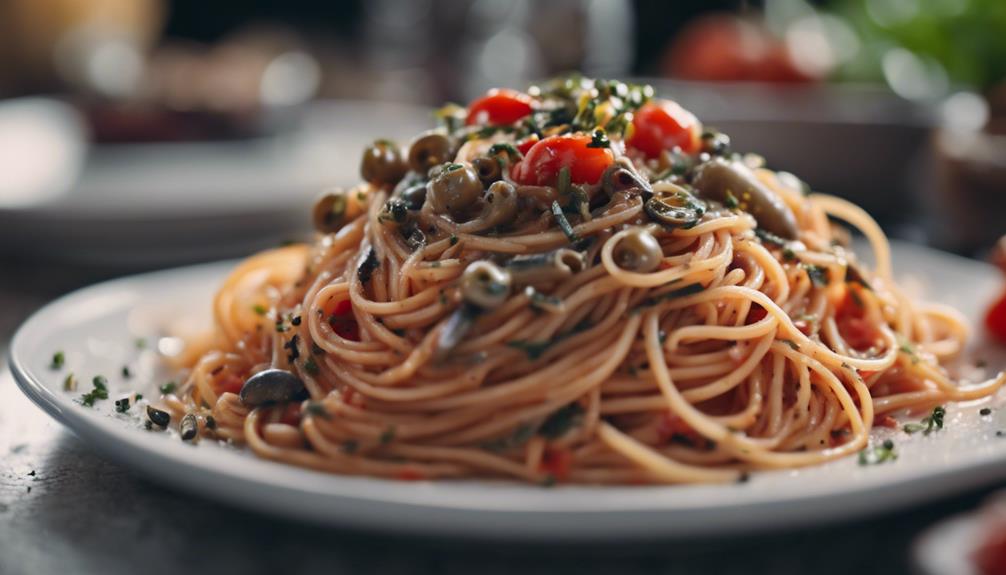
The bold and robust flavor profile of Puttanesca sauce stems from its combination of umami-rich anchovies, briny olives, and tangy capers.
Anchovies play an essential role in Puttanesca sauce, infusing it with a deep, savory taste that adds complexity to the dish.
The briny essence from olives and capers contributes a salty depth that enhances the overall flavor of the sauce, offering a Mediterranean flair.
Tomatoes bring a zesty tanginess to the sauce, balancing the umami and brininess with a touch of acidity, creating a harmonious blend of flavors.
This triumvirate of flavors creates a sensory experience that's both bold and satisfying, making spaghetti alla Puttanesca a popular choice for those seeking a dish that tantalizes the taste buds with its rich and robust taste profile.
Ingredients for Puttanesca Sauce
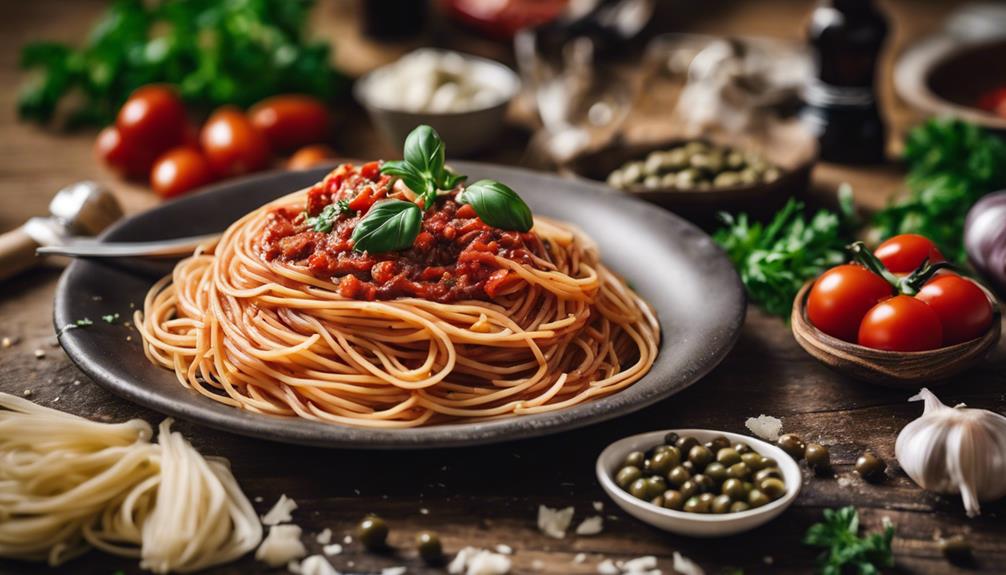
An essential component of Puttanesca sauce, the combination of San Marzano tomatoes, garlic, anchovies, olives, and capers creates a flavorful base for this classic Italian dish.
To begin the preparation of Spaghetti alla Puttanesca, you'll need to gather these key ingredients. Start by heating olive oil in a pan and sautéing minced garlic until fragrant.
Then, add in chopped anchovies, which will dissolve into the sauce, providing a rich umami flavor. The next step is to introduce pitted olives and briny capers, adding a tangy and salty kick to the puttanesca sauce.
For those who enjoy a bit of heat, a sprinkle of red pepper flakes can elevate the dish with a subtle spiciness. Lastly, incorporating the vibrant San Marzano tomatoes will bring a luscious and robust texture to the sauce, tying all the flavors together harmoniously.
These ingredients come together to form the bold and savory puttanesca sauce, perfect for coating your choice of pasta in this traditional Italian pasta recipe.
Making Spaghetti Puttanesca
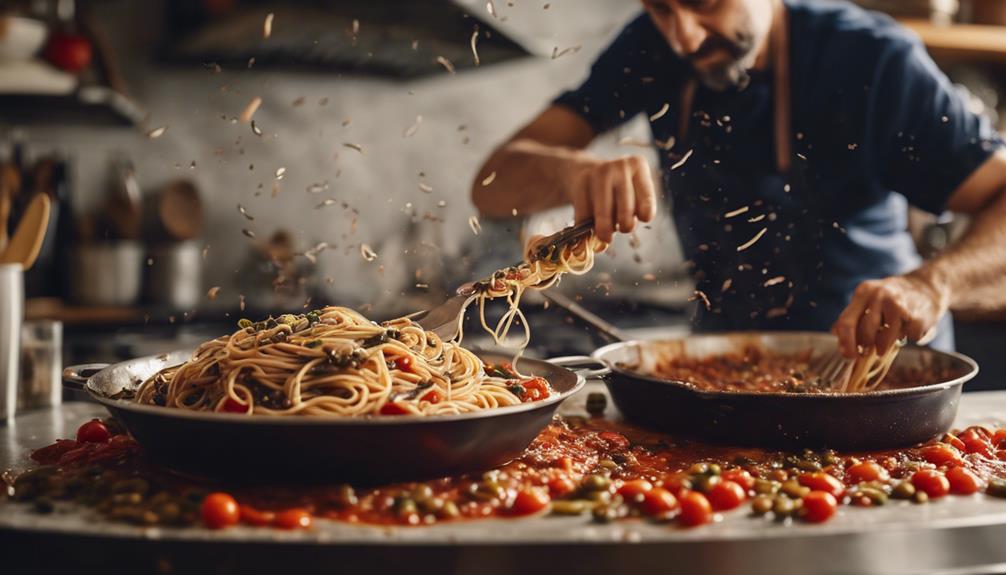
To make Spaghetti Puttanesca, start by boiling a pot of water for your pasta. While the water is heating up, gather the necessary ingredients and follow this simple recipe:
- Recipe: Heat olive oil in a pan and sauté minced garlic until fragrant.
- Ingredients: Add anchovies, capers, and chopped tomatoes to the pan, allowing the flavors to meld together.
- Steps: Toss in olives and let the sauce simmer for a few minutes before mixing in the cooked spaghetti.
Spaghetti alla Puttanesca is characterized by its briny flavors, thanks to the combination of anchovies, capers, and olives. This quick and easy dish is perfect for a flavorful meal without much effort.
The robust taste of the sauce, enriched by the umami of the anchovies, makes Spaghetti Puttanesca a popular choice among pasta enthusiasts worldwide.
Serving Suggestions for Puttanesca
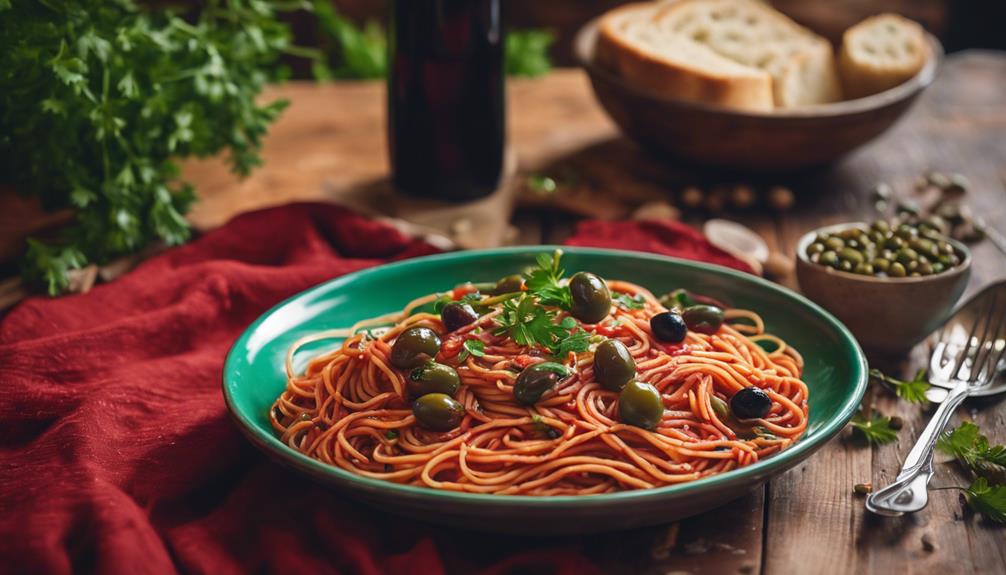
For a delightful dining experience, consider enhancing the bold flavors of Puttanesca with complementary side dishes and beverages.
When serving Puttanesca, opt for a classic pairing with spaghetti to soak up the robust flavors of the sauce. Additionally, consider offering a side salad like Panzanella or arugula salad to balance the richness of the dish. To elevate your meal further, a glass of red wine can complement the savory and tangy notes of Puttanesca, creating a harmonious flavor combination. Don't forget to include crusty bread on the table for dipping into the sauce and enjoying every last bit of flavor.
For a more indulgent option, consider serving Parker House rolls or garlic butter bread bites alongside your Puttanesca for a delightful dining experience. These buttery and savory bread options can add a delicious touch to your meal and provide a satisfying accompaniment to the bold flavors of the dish.
Frequently Asked Questions
What Does Puttanesca Taste Like?
Puttanesca tastes bold and robust, offering a unique blend of umami from anchovies, brininess from olives and capers, and a tangy kick from tomatoes. The combination creates a savory, salty, and slightly spicy flavor profile that tantalizes your taste buds.
What Is Puttanesca in Italian?
In Italian, "puttanesca" translates to "in the style of the prostitute." This traditional pasta sauce hails from Naples and boasts a flavorful mix of tomatoes, garlic, anchovies, olives, and capers for a bold taste.
Why Is Puttanesca so Good?
You love Puttanesca because of its bold flavors. The briny olives, capers, and rich anchovies create a unique umami taste. High-quality ingredients like San Marzano tomatoes add sweetness, making this quick and easy dish a favorite worldwide.
Is Puttanesca Good for You?
Puttanesca is good for you due to its rich antioxidants and omega-3 fatty acids from ingredients like tomatoes and anchovies. Enjoyed in moderation, it offers health benefits like heart support and immune health, making it a nutritious choice.
What Are Some Other Bold and Flavorful Italian Dishes Similar to Spaghetti Puttanesca?
Looking for bold and flavorful Italian dishes like spaghetti puttanesca? Try indulging in a hearty Italian pasta soup, such as minestrone or pasta e fagioli. These savory and comforting soups are packed with robust flavors and are sure to satisfy those seeking a delicious Italian meal.
Conclusion
To sum up, spaghetti puttanesca is a bold and flavorful Italian dish that has a rich history and a unique taste profile.
With its combination of anchovies, capers, olives, and tomatoes, puttanesca sauce offers a savory and tangy experience that's sure to delight the taste buds.
Whether enjoyed on its own or paired with a side of garlic bread, this dish is a delicious and satisfying choice for any Italian cuisine enthusiast.
Buon appetito!
